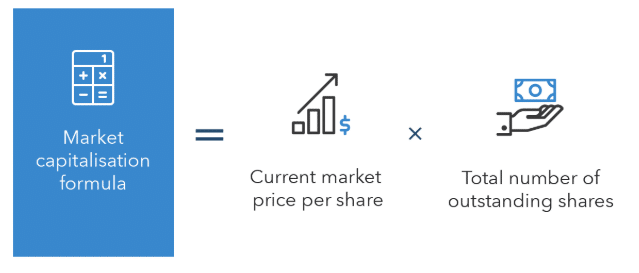What is Market Capitalization?
Market capitalization is the total dollar market value of the outstanding shares of stocks of a company. It is commonly referred to as a market cap. To get the market capitalization, one has to multiply the total number of a company’s outstanding shares by the market price of a single share. Market capitalization is one of the quickest and easiest method for understanding the company’s value. You can multiply the share price by the number of shares available. Market capitalization becomes one of the key figures as the size is a basic determinant of what investors are interested in a company.
The market cap of a company is first established via an IPO or Initial Public Offering. Before this, however, the company has to enlist in the bank to employ valuation techniques. They thus derive the company’s value and determine how many shares they offer to the public and at what price.
The company starts trading on an exchange after going public. The supply and demand for the shares determine its price. The price of shares increases if there are favorable factors increasing its demand. The opposite happens when there is no demand. The real-time estimate of the company’s value becomes the market cap.
Real Stock Market Capitalization Example
Market Cap is an effective instrument for risk assessment as well as a tool for diversifying one’s portfolio with company stocks of different sizes. Thus, companies can be divided into large-cap, mid-cap, and small-cap categories.
- Large-cap: Large-cap or big-cap companies have a market cap of $10 billion or more and have usually operated for a long time. They are usually big brands in well-established industries. There is no guarantee of huge returns in a short period of time if one invests in big-cap companies. However, they generally tend to produce consistent growth and increase in value over a long period of time. Examples of big-cap companies include Johnson &Johnson (JNJ) and International Business Machines (IBM).
- Mid-cap companies: Companies with a market cap between $2 billion and $10 billion are Mid-cap companies. They are generally companies that people expect to rapidly grow over a period of time. Because they don’t have an established presence, they come with higher inherent risks compared to investing in large-cap companies. Eagle Materials Inc is an example of a mid-cap company.
- Small-cap companies: Small-cap companies have a market capitalization between $300 million and 2 billion. They usually are new companies that serve newer industries or niche markets.
How Market Capitalization helps to value a stock
One can calculate a company’s market capitalization by multiplying the total number of outstanding shares by the stock’s current price. For instance, if the share price is $50 each and there are one million shares, the market cap of the company is $50,000,000.
Market capitalization can correspond to any stage in a company’s business development. Investors consider large-cap stocks as more conservative than small-cap or mid-cap investments. They pose less risk but have the less aggressive potential for growth. Mid-cap stocks, on the other hand, are in the middle of the risk/return spectrum, between large caps and small caps.
Companies classified as mid-cap might be in the process of improving overall competitiveness and increasing their market share. This stage is critical in determining whether a company grows up to reach its full potential or not.
Small-cap companies are relatively more susceptible to an economic or business downturn as they have relatively fewer resources. They are also susceptible to uncertainties of untried markets, as well as cut-throat competition. However, small-cap stocks offer significant growth-potential to investors in it for the long-run. In the short-term, they have to be resistant to volatile stock price swings.
Investors can gauge the performance of an investment by comparing it with similar investments in an index. Indices come in all shapes and sizes in the case of stocks. The best-known benchmark for large-cap stocks is Standard & Poor’s (S&P) 500, with variants available for small and mid-cap companies as well. A prominent index for small-cap stocks is Russell 2000.
Large-cap, mid-cap, or small-cap stocks are affected differently by economic and market developments. For this reason, investors maintain a mix of market caps in their portfolios to diversify. For instance, small and mid-cap stocks can appreciate in value when large caps are declining. This helps compensate for any losses they may suffer.
Investors should properly evaluate their risk tolerance, financial goals, and time horizon to build a properly mixed portfolio consisting of different market caps. A well-diversified portfolio containing a healthy mix of small, mid, and big-cap companies reduces investment risk in any area, helping investors to pursue their long-term financial goals. However, the risk of potential loss is not completely eliminated by diversifying portfolios.









